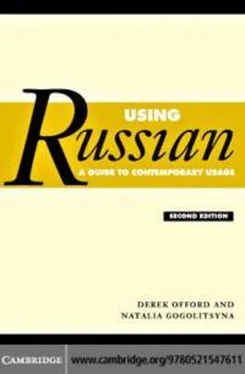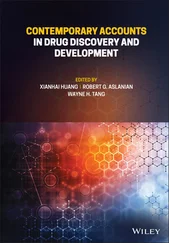Derek Offord - Using Russian - A Guide to Contemporary Usage
Здесь есть возможность читать онлайн «Derek Offord - Using Russian - A Guide to Contemporary Usage» весь текст электронной книги совершенно бесплатно (целиком полную версию без сокращений). В некоторых случаях можно слушать аудио, скачать через торрент в формате fb2 и присутствует краткое содержание. Год выпуска: 2005, Издательство: Cambridge, Жанр: Языкознание, на английском языке. Описание произведения, (предисловие) а так же отзывы посетителей доступны на портале библиотеки ЛибКат.
- Название:Using Russian : A Guide to Contemporary Usage
- Автор:
- Издательство:Cambridge
- Жанр:
- Год:2005
- ISBN:нет данных
- Рейтинг книги:4 / 5. Голосов: 1
-
Избранное:Добавить в избранное
- Отзывы:
-
Ваша оценка:
- 80
- 1
- 2
- 3
- 4
- 5
Using Russian : A Guide to Contemporary Usage: краткое содержание, описание и аннотация
Предлагаем к чтению аннотацию, описание, краткое содержание или предисловие (зависит от того, что написал сам автор книги «Using Russian : A Guide to Contemporary Usage»). Если вы не нашли необходимую информацию о книге — напишите в комментариях, мы постараемся отыскать её.
Using Russian : A Guide to Contemporary Usage — читать онлайн бесплатно полную книгу (весь текст) целиком
Ниже представлен текст книги, разбитый по страницам. Система сохранения места последней прочитанной страницы, позволяет с удобством читать онлайн бесплатно книгу «Using Russian : A Guide to Contemporary Usage», без необходимости каждый раз заново искать на чём Вы остановились. Поставьте закладку, и сможете в любой момент перейти на страницу, на которой закончили чтение.
Интервал:
Закладка:
diminishing in the former Soviet republics in proportion as the
languages of the ethnic groups that are dominant in the new states (e.g.
Kazakhs in Kazakhstan) are promoted, particularly within the
educational system. Admittedly Russian remains a lingua franca for
commercial and diplomatic transactions in the former Soviet republics, especially among the older generation of speakers who were educated
in Soviet times, when Russian was the dominant language throughout
the Union. On the other hand, the rise of English as the language of global communication, and therefore the first foreign language to be taught in schools, may further weaken the status of Russian outside the Russian Federation. One may predict that in twenty or thirty years
Russian will be less widely spoken in the former Soviet republics than it is today, especially in those countries with a relatively small residual ethnic Russian population (e.g. Lithuania). It is also possible that many people who do speak Russian in those countries will use it less than they do today and that they will have a poorer command of it than
non-Russians who speak Russian there now.
Russian is of course also spoken, with varying degrees of fluency,
accuracy and proximity to the Russian now spoken in Russia itself, by many émigrés or their descendants in countries outside the former
Soviet Union. Russians, or members of other ethnic groups who were
formerly Soviet citizens, have left the Soviet Union – or not returned to it – at four main periods in the last ninety years or so: in the years immediately or soon after the Bolshevik revolution of 1917; after the Second World War (1939–45), following their displacement; in the
Brézhnev period (especially in the 1970s, after the granting of
permission to Jews to leave the country); and from the mid-1980s,
following the further relaxation of emigration controls. The principal destinations of these emigrants, at one time or another, have been
France, Germany, Britain, the US and Israel. Many members of the
Russian diaspora are permanently settled abroad but some – mainly
more recent émigrés – are only temporarily resident outside Russia,
perhaps because they are working or studying abroad.
Russian is also spoken by millions of people as a foreign language,
especially people from Africa, Asia, Latin America and Eastern Europe who received all or most of their higher education in the Soviet
Union. Moreover, Russian has been widely taught outside Russia
since the Second World War, particularly when the Soviet Union was
at its most powerful from the 1960s to the1980s. Organisations such as the International Association of Teachers of the Russian Language and Literature (Meждунaро´днaя aссоциa´ция прeподaвa´тeлeй ру´сского
языкaór MAПPЯ
´ л) were set up in the Soviet period to support such
activity. However, the number of foreigners learning Russian
(estimated at some 20 million in 1979) has diminished in the
5
1
Varieties of language and register
post-Soviet period, following the demise of Russian hegemony in the
Eastern bloc countries (East Germany, Poland, Czechoslovakia,
Hungary, Romania and Bulgaria) and the weakening of Russian
influence in various states in other parts of the world (e.g. Cuba,
Angola, Ethiopia, North Yemen and Vietnam).
It should be added, finally, that Russian is one of the official and working languages of the United Nations and UNESCO.
Although Russian is thus widely distributed, and although it is also the language in which one of the world’s great bodies of imaginative literature has been created over the last two and a half centuries, it is with the varieties of Russian that are spoken by ethnic Russians in
Russia today that this book is primarily concerned.
1.2
Varieties of language
The student learning a foreign language in a systematic way will
generally study a form of it, or the single form of it, which educated native speakers consider normative, e.g. ‘BBC English’, Parisian
French, Tuscan Italian, Mandarin or Cantonese. In the case of Russian this normative form is what Russians refer to as the ‘literary language’
(литeрaту´рный язы´к). However, the term ‘literary language’ suggests to an English-speaker exclusively the written language, and the
expression ‘standard Russian’ is therefore preferred in this book.
Standard Russian embraces the spoken language of educated people as
well as the written language, and its spoken form is based on educated Muscovite speech.
Study of the normative form of a language should inculcate a
standard pronunciation and vocabulary and ‘correct’ grammatical rules.
It is essential that the foreign student absorb such a norm both in order that he or she should be able to communicate with educated speakers
of the language in a way acceptable to the largest possible number of them, and in order to establish criteria in his or her own mind for
judging correctness and error in the language.
However, there comes a point in one’s study of a foreign language
when it also becomes necessary to recognise that the concept of norms is to some extent theoretical and abstract. This is so because a living language is constantly evolving and because innumerable varieties of it exist both within what is regarded as the norm and beyond the limits of that norm.
For one thing, what people consider correct changes with the
passage of time. For example, authoritative Russian dictionaries
indicate end stress throughout the future tense in the verbs помeсти´ть
and посeли´ть (помeсти´шь, etc., посeли´шь, etc.), but many educated speakers now consider помe´стишь, etc. and посe´лишь, etc. normal
and correct. As far as the historical evolution of Russian is concerned, the student needs to be aware that while the Russian of P úshkin,
Turgénev and Tolst ói is easily comprehensible to Russians today, it differs in some respects morphologically and especially lexically from 6
1.2
Varieties of language
the contemporary language. Moreover, Russian is undergoing rapid
change at the present time. This change is due to some extent to the global technological and managerial revolution of the late twentieth century, with its large new vocabulary, but also to the quite sudden breakdown of the communist order in Russia and the political,
economic, social and cultural innovations and dislocations which that breakdown has entailed. The concerns that these linguistic changes
have generated among educated Russians are dealt with in section 1.6
below.
More importantly from the point of view of this book, the language
spoken in Russia today, while having a common core, has numerous
varieties, as do modern English, French, German, Spanish and so on.
For native users of a language do not all use their language in the same way. The language they use may vary depending on such factors as
where they come from, which social group they belong to, whether
they are speaking or writing, and how formal the context is in which they are communicating. In other words varieties of language are,
in the terminology of the Romanian linguist Coseriu, diatopic (that
is to say, characteristic of a particular place, as are regional dialects), diastratic (characteristic of a certain stratum, as are social dialects), diamesic (determined by medium, e.g. whether the example of
language is written or spoken), or diaphasic (determined by degree
Читать дальшеИнтервал:
Закладка:
Похожие книги на «Using Russian : A Guide to Contemporary Usage»
Представляем Вашему вниманию похожие книги на «Using Russian : A Guide to Contemporary Usage» списком для выбора. Мы отобрали схожую по названию и смыслу литературу в надежде предоставить читателям больше вариантов отыскать новые, интересные, ещё непрочитанные произведения.
Обсуждение, отзывы о книге «Using Russian : A Guide to Contemporary Usage» и просто собственные мнения читателей. Оставьте ваши комментарии, напишите, что Вы думаете о произведении, его смысле или главных героях. Укажите что конкретно понравилось, а что нет, и почему Вы так считаете.












